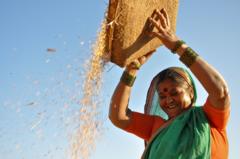Despite U.S. pressure on India to open agricultural markets for corn exports, India maintains its protective stance on farming, prioritizing local farmers' interests over trade negotiations.
India’s Agricultural Stance Amidst U.S. Trade Pressures

India’s Agricultural Stance Amidst U.S. Trade Pressures
As the U.S. seeks to boost corn exports to India, local farmers stand firm against potential impacts on their livelihoods.
Why is India resistant to purchasing U.S. corn, even under the scrutiny of U.S. officials? This question emerged prominently after U.S. Commerce Secretary Howard Lutnick criticized India's agricultural policies, highlighting perceived barriers against American farmers. The intensifying trade war with the U.S., marked by reciprocal tariffs set to commence soon, has placed agriculture at the forefront of negotiations. President Donald Trump has criticized India for its high tariffs, labeling it a "tariff king" and an exploitative trade partner.
India, once reliant on food imports, has made significant strides to become a self-sufficient agricultural powerhouse. Through technological advancements, the nation transformed from food scarcity in the mid-20th century to being the world's top milk producer and a major exporter of agricultural products. India now feeds its vast population and ranks as the eighth-largest agri-produce supplier globally, exporting diverse products such as rice, shrimp, and honey.
However, despite these advancements, challenges within the agricultural sector persist. Indian farmers, averaging less than a hectare of land, face low productivity and struggles against global price shifts and climate change. High tariffs, which can reach as much as 150%, are in place to protect local farmers from cheaper imports, as productivity lags far behind global standards.
The current bilateral trade between India and the U.S. is modest, with India primarily exporting specialty crops while the U.S. looks to expand its agricultural exports. Experts contend that U.S. demands for lower tariffs and acceptance of genetically modified crops threaten the livelihoods of millions of Indian farmers who rely on subsistence farming. Furthermore, U.S. agricultural subsidies create an uneven playing field, jeopardizing smallholder farmers in India.
Beyond global dynamics, domestic issues plague India's agricultural landscape. Investment remains low, representing less than 6% of total national investments, impacting essential infrastructure and modernization. Farmers have voiced discontent in the past through protests, advocating for better prices and government support.
Negotiating with the U.S. brings additional complexities, as experts highlight the need for balance between American export interests and India's agricultural needs. A cautious approach from India, prioritizing its national interests while engaging in negotiations, remains vital to safeguard the agricultural sector.
With the stakes high, India's strategy may involve leveraging other trade negotiations to maintain an advantageous position without compromising its agricultural integrity. Ultimately, the path forward lies in equipping India's agricultural sector for modernization while ensuring that the voices of local farmers are heard and valued.






















